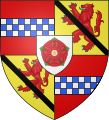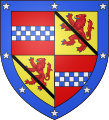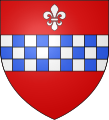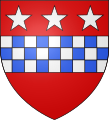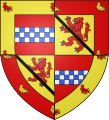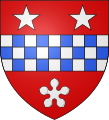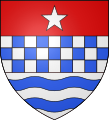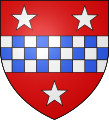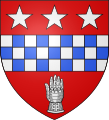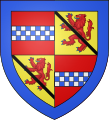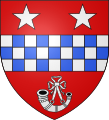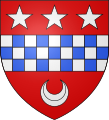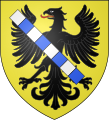
Earl of Crawford is one of the most ancient extant titles in Great Britain, having been created in the Peerage of Scotland in 1398 for Sir David Lindsay. It is the premier earldom recorded on the Union Roll.
David Lindsay may refer to:
Gille Críst, Earl of Angus ruled until 1206 Mormaer of Angus. He was a son of Gille Brigte of Angus and younger brother of Adam of Angus.

Edzell Castle is a ruined 16th-century castle, with an early-17th-century walled garden. It is located close to Edzell, and is around 5 miles (8 km) north of Brechin, in Angus, Scotland. Edzell Castle was begun around 1520 by David Lindsay, 9th Earl of Crawford, and expanded by his son, Sir David Lindsay, Lord Edzell, who also laid out the garden in 1604. The castle saw little military action, and was, in its design, construction and use, more of a country house than a defensive structure. It was briefly occupied by English troops during Oliver Cromwell's invasion of Scotland in 1651. In 1715 it was sold by the Lindsay family, and eventually came into the ownership of the Earl of Dalhousie. It was given into state care in the 1930s, and is now a visitor attraction run by Historic Environment Scotland. The castle consists of the original tower house and building ranges around a courtyard. The adjacent Renaissance walled garden, incorporating intricate relief carvings, is unique in Scotland. It was replanted in the 1930s, and is considered to have links to esoteric traditions, including Rosicrucianism and Freemasonry.

Clan Dundas is a Scottish clan.
Lord Spynie is a title in the Peerage of Scotland. It was created on 4 November 1590 for Sir Alexander Lindsay, younger son of David Lindsay, 10th Earl of Crawford. The title became dormant on the death of the third Lord in 1671.

Clan Ogilvy, also known as Clan Ogilvie, is a Highland Scottish clan. Originating from Angus, Scotland, the progenitor of the Clan received a barony from King William the Lion in 1163. In 1491, King James IV elevated Sir James Ogilvy as Lord Ogilvy of Airlie.
Alexander or Alex Lindsay may refer to:
John Lindsay of Balcarres (1552–1598) was Secretary of State, Scotland. On 5 July 1581 he was appointed a Lord of Session under the title Lord Menmuir.
David Lindsay, 3rd Earl of Crawford was a regent to James II of Scotland. He was a member of Clan Lindsay, a Scottish Lowland clan. He was the son of Alexander Lindsay, 2nd Earl of Crawford by his wife Marjorie.

Balcarres House lies 1km north of the village of Colinsburgh, in the East Neuk of Fife, in eastern Scotland. It is centred on a mansion built in 1595 by John Lindsay (1552–1598), second son of David, 9th Earl of Crawford. The house became the family seat of the Earl of Crawford. The present house is the result of substantial extensions in the early nineteenth century, using part of a fortune made in India, but preserves much of the original mansion.
Sir David Lindsay of Edzell, Lord Edzell (1551?–1610) was a Scottish judge.

Alexander Lindsay, 1st Lord Spynie was a Scottish nobleman. His death is the subject of the ballad Lord Spynie.
Alexander Lindsay, 2nd Lord Spynie was a Scottish nobleman and soldier of fortune.

Lady Anna Mackenzie (1621–1707), also Ann MacKenzie, was a Scottish courtier, wife of the first Earl of Balcarres and the mother of the second and third. After her first husband died, she married Archibald Campbell, 9th Earl of Argyll. She was a governess to William III when he was a child. Mackenzie suffered because she was a Jacobite and her second husband was executed for leading a rising against James VII and II which was intended to support the Monmouth Rebellion. She worked to keep together the estates of Balcarres despite the tumultuous times in which she lived and her family's support of the Jacobite cause. Her memoirs were published more than a century after her death.

John Lindsay, 17th Earl of Crawford, 1st Earl of Lindsay was a Scottish nobleman.
Sir William de Lindsay (1155–1205), Lord of Crawford, Baron of Luffness, Justiciar of Lothian was a 12th-century Scottish noble.
David Lindsay, 10th Earl of Crawford (1527-1574) was a Scottish landowner.
Katherine Campbell, Countess of Crawford born Katherine Campbell was a Scottish noblewoman. She married twice and controlled a substantial inheritance.

Sir James (de) Lindsay, 9th Lord of Crawford, Knight Banneret, Lord of Crawford, Kirkmichael, Wigton, Symontoun, and of many other baronies, claiming also to be Lord of Buchan, was a Scottish feudal lord.





